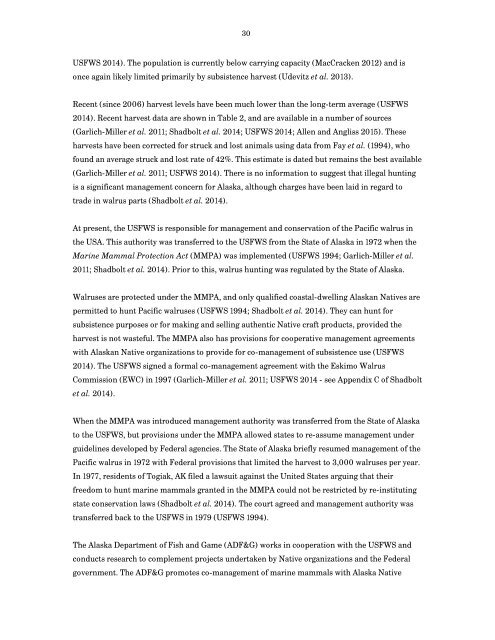The State of Circumpolar Walrus Populations
walrusreport
walrusreport
You also want an ePaper? Increase the reach of your titles
YUMPU automatically turns print PDFs into web optimized ePapers that Google loves.
30<br />
USFWS 2014). <strong>The</strong> population is currently below carrying capacity (MacCracken 2012) and is<br />
once again likely limited primarily by subsistence harvest (Udevitz et al. 2013).<br />
Recent (since 2006) harvest levels have been much lower than the long-term average (USFWS<br />
2014). Recent harvest data are shown in Table 2, and are available in a number <strong>of</strong> sources<br />
(Garlich-Miller et al. 2011; Shadbolt et al. 2014; USFWS 2014; Allen and Angliss 2015). <strong>The</strong>se<br />
harvests have been corrected for struck and lost animals using data from Fay et al. (1994), who<br />
found an average struck and lost rate <strong>of</strong> 42%. This estimate is dated but remains the best available<br />
(Garlich-Miller et al. 2011; USFWS 2014). <strong>The</strong>re is no information to suggest that illegal hunting<br />
is a significant management concern for Alaska, although charges have been laid in regard to<br />
trade in walrus parts (Shadbolt et al. 2014).<br />
At present, the USFWS is responsible for management and conservation <strong>of</strong> the Pacific walrus in<br />
the USA. This authority was transferred to the USFWS from the <strong>State</strong> <strong>of</strong> Alaska in 1972 when the<br />
Marine Mammal Protection Act (MMPA) was implemented (USFWS 1994; Garlich-Miller et al.<br />
2011; Shadbolt et al. 2014). Prior to this, walrus hunting was regulated by the <strong>State</strong> <strong>of</strong> Alaska.<br />
<strong>Walrus</strong>es are protected under the MMPA, and only qualified coastal-dwelling Alaskan Natives are<br />
permitted to hunt Pacific walruses (USFWS 1994; Shadbolt et al. 2014). <strong>The</strong>y can hunt for<br />
subsistence purposes or for making and selling authentic Native craft products, provided the<br />
harvest is not wasteful. <strong>The</strong> MMPA also has provisions for cooperative management agreements<br />
with Alaskan Native organizations to provide for co-management <strong>of</strong> subsistence use (USFWS<br />
2014). <strong>The</strong> USFWS signed a formal co-management agreement with the Eskimo <strong>Walrus</strong><br />
Commission (EWC) in 1997 (Garlich-Miller et al. 2011; USFWS 2014 - see Appendix C <strong>of</strong> Shadbolt<br />
et al. 2014).<br />
When the MMPA was introduced management authority was transferred from the <strong>State</strong> <strong>of</strong> Alaska<br />
to the USFWS, but provisions under the MMPA allowed states to re-assume management under<br />
guidelines developed by Federal agencies. <strong>The</strong> <strong>State</strong> <strong>of</strong> Alaska briefly resumed management <strong>of</strong> the<br />
Pacific walrus in 1972 with Federal provisions that limited the harvest to 3,000 walruses per year.<br />
In 1977, residents <strong>of</strong> Togiak, AK filed a lawsuit against the United <strong>State</strong>s arguing that their<br />
freedom to hunt marine mammals granted in the MMPA could not be restricted by re-instituting<br />
state conservation laws (Shadbolt et al. 2014). <strong>The</strong> court agreed and management authority was<br />
transferred back to the USFWS in 1979 (USFWS 1994).<br />
<strong>The</strong> Alaska Department <strong>of</strong> Fish and Game (ADF&G) works in cooperation with the USFWS and<br />
conducts research to complement projects undertaken by Native organizations and the Federal<br />
government. <strong>The</strong> ADF&G promotes co-management <strong>of</strong> marine mammals with Alaska Native


